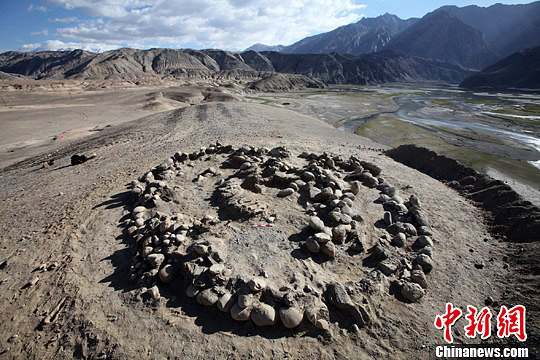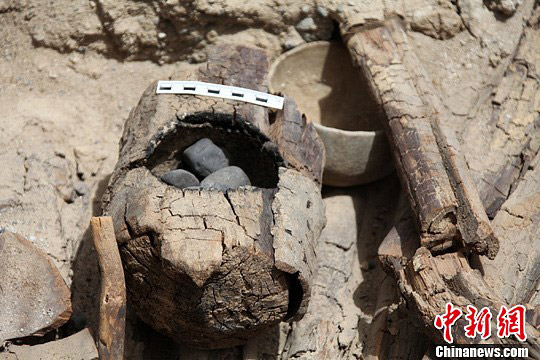Zoroastrianism was the state religion of the ancient Persian Empire. Its founder, Zoroaster, or Zarathustra, is thought to have been born in what is now Northeast Iran or Southwest Afghanistan. A 2004 survey by the Zoroastrian Associations of North America put the estimated number of believers worldwide at between 124,000 and 190,000.
Now, archaeologists in Northwest China’s Xinjiang Uygur Autonomous Region have discovered major Zoroastrian tombs, dated to over 2,500 years ago. This unravelling is leading to startling controversial speculation about the religion’s origin.

Archaeologists in Northwest China’s Xinjiang Uygur Autonomous Region have
discovered major Zoroastrian tombs, dated to over 2,500 years ago.
discovered major Zoroastrian tombs, dated to over 2,500 years ago.
On China’s sparsely populated Pamir Plateau, ancient people lived and battled, and created a marvelous civilization. These massive tombs, now being excavated, are the world’s earliest traces of the religion of Zoroastrianism found so far.
Zoroastrianism took form even before the rise of Persian Empire, which later adopted it as the state religion. The sun and fire are central to the religion, and the signs are found everywhere in the tombs.
"This is a typical wooden brazier found in the tombs. Zoroastrians would bury a burning brazier with the dead to show their worship of fire. The culture is unique to Zoroastrianism."
Today, most of the ancient glories lie in ruins. But the dig now offers a glimpse of what life here looked like over 25 centuries ago.
"This polished stoneware found in the tombs is an eyebrow pencil used by ordinary ladies. It does not just show the sophistication of craftsmanship here over 2,500 years ago, but also demonstrates the ancestors’ pursuit of beauty, creativity and better life, not just survival. It shows this place used to be highly civilized."
This is the biggest excavation of the tombs of Zoroastrianism here in Xinjiang’s history. Some archaeologists say the excavation is likely to prove that this religion is originated from the Pamir Plateau, right here beneath of our feet.
"All the evidence leads to one conclusion: Zoroastrianism originated in the east on China’s Pamir Plateau. To this day, archaeologists are still arguing over where the religion originated, but here, we have found the earliest and the largest scale of Zoroastrian ruins, with all the typical symbols of this religion. Of course, there’s the possibility that there are other undiscovered ruins elsewhere in the world. But at this moment, it’s a logical conclusion that the origin of the religion is here, not in Persia." said Wu Xinhua, Xinjiang Director, Archaeological Inst., Chinese Academy of Social Sciences.
Logical, perhaps. Startling and controversial, certainly. And as the excavation continues, the Pamir Plateau is bound to yield more amazing discoveries.

Archaeologists in Northwest China’s Xinjiang Uygur Autonomous Region have discovered
major Zoroastrian tombs, dated to over 2,500 years ago.
major Zoroastrian tombs, dated to over 2,500 years ago.
5 comments:
The idea that finding tombs in Xinjiang proves that Zoroastrianism started there is far fetched. I don't see any firm dates, but "over 2500 years" would put these tombs about 500 years after the mostly likely birth of Zarathustra (ca 1200-1000 BCE).
What I do find interesting is how this evidence fits into Michael Witzel's theory about early migrations of Zoroastrian people, especially into India to become the precursors of the hill tribes of Kosala - especially the Śākya tribe to which the Buddha is said to belong. The fact that their burial mounds are round (consistent with Scythian "kurgans") is intriguing as one of the features that distinguish the Śākyas (and others) from Brahmins is their round burials - the Brahmins made square burial mounds and recorded their rejection of the round mounds as improper (in the Śatapathabrāhmaṇa for example).
My outline of Witzel's theory and evaluation of the evidence is in the Journal of the Oxford Centre for Buddhist Studies. Vol. 3.
Jayarva, which scholars/sources place the birth of Zarathustra around 1200-1000 BCE? On what evidence?
Well I'm most familiar with the work of Mary Boyce (RIP). The evidence is very sparse and uncertain. As far as I know no one talks about his "birth" and it was sloppy of me to mention it. But he must have flourished around that time.
A place to start is the Encyclopedia Iranica (with many articles by Boyce)> It introduces a survey of the evidence thus: "If anything approaching a consensus exists, it is that he lived ca. 1000 BCE give or take a century or so, though reputable scholars have proposed dates as widely apart as ca.1750 BCE and '258 years before Alexander.'" The article concludes with a good bibliography of source material.
Also "In the Avesta, the geography of the Vendīdād and of the Yašts make it clear that these texts locate themselves in eastern Iran. Even though there are later traditions which place him in Azerbaijan and Media, it is more reasonable to locate Zoroaster somewhere in eastern Iran along with the rest of the Avesta."
For more background on the migration of the Scythians see the section in my article mentioned above (and the sources I mention there). If Witzel is correct, and I think he probably is, then Zoroastrianism must have existed prior to 850 BCE because that's roughly when the Śākyas migrated into the Nepalese foothills and introduced Zoroastrian ideas about ethics to that part of the world.
I'm surprised that this report or newscast doesn't reflect any knowledge of the history of Zoroastrianism, nor of archaeology in Iran. It seems the archaeologists and people behind it wanted to claim that such early remains in Xinjiang are the oldest anywhere. ?? But there's a large relatively intact mud-brick Median Zoroastrian temple near Hamadan that was excavated last century which dates from to the 8th or 7th cent. BC, which predates Cyrus and the rise of the Persians. It's a tourist attraction today. "Over 2500 years old" isn't nearly specific enough.
Well what i have concluded so fars is zoroaster may not even be a historicsl perosn but there was a reformed doctorine out of larger indo iranian pool in eat of iran and i think ahira mazda was not zoroasterian exclusive supreme god as we have the other versiin in assyria and also as Qormusta Tengri in mongolia abd among turkic and mongolian tribes
Post a Comment